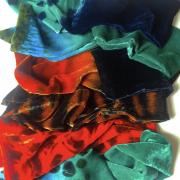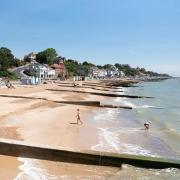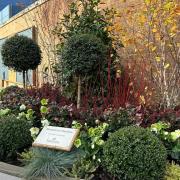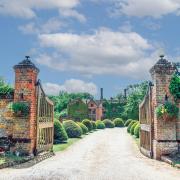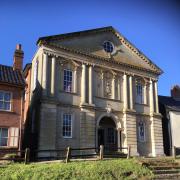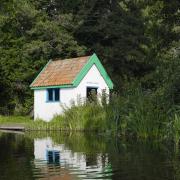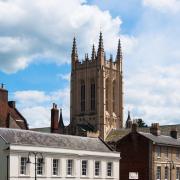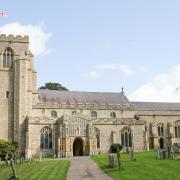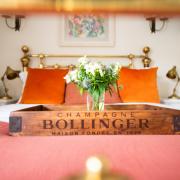Was a Suffolk castle part of a huge, ancient kingdom, or an illegal stronghold at the heart of a bloody war?
Framlingham Castle is one of Suffolk’s most visited historic sites, not least because global superstar singer-songwriter Ed Sheeran made it the subject of his hit Castle on the Hill. Framlingham Castle has a wonderfully rich and well researched history, so we know that, while there would have been a small slope in that part of Framlingham when the castle was built, the 'hill' on which Framlingham Castle stands was, in fact, the site of an even earlier motte and bailey castle. Earth was dug to form the castle mound, creating, in turn, a defensive moat below.
It wasn't the only one. A few miles west of Ipswich, there was once a castle, built on the very top of a naturally high hill. The many myths, legends and names attached to this ancient earthwork and moat, and the motte and bailey which once stood at 'Offetuna' - which we now know as Offton - are certainly worth exploring.
Whether they were constructed for tactical and feudal purposes, or for show, to demonstrate power, no fewer than 27 castles popped up in Suffolk between the Norman Conquest, in 1066, and 1200. Norman knight Roger Bigod, Duke of Norfolk, built Framlingham, Orford, Eye, Bungay and stronholds in the region. But no one is entirely sure who built Offton castle, or where the 'Off' part of the name came from.
What we can be reasonably certain of is that 'tuna' and 'ton' allude to a settlement, farmstead or homestead. But who settled the village? Did they build the castle? If so, why? A person, or even a king or two called Offa, has long been the theory, but there could be more than one Offa on offer here, and things might not be quite what we expect them to be.
Spreading out like spokes in a wheel, are at least five ancient public footpaths leading to the site of the former fortification at Offton. The route to the top of the hill that I chose to walk has probably always been the main path - it becomes a private driveway to a farm near the top, diverting east, away from the farm and converted barns, taking you close to the edge of the castle moat. Standing on the ancient, unaltered earthwork where the castle once stood, with the wildness of the countryside and the tranquillity of the moat, there's a view across fields to the Norwich Road area of Ipswich. It's just six miles distant, yet seems worlds away.

The earthwork is square and measures about 50m x 50m. The castle would have been made of timber on a stone base. The moat ditches are about 15m wide. It has been estimated by Suffolk Archaeology Society that it would have taken 1,000 people two years to construct the earthworks. They, and dwellers of Offton, would have been sustained by Offton Channel which cuts through the village below.
According to monument records, there is evidence of another enclosure to the south of the earthwork which looks like an early ditch site. Before trees and shrubs covered the plateau, there would have been a 360 degrees panorama, perfect for spotting invaders heading your way, especially from the ancient port of Ipswich and the coast. When researching the Dark Ages after the Romans left, the word 'possible' is impossible to avoid, but King Offa of Mercia, crowned in 757, has long been assumed to have been the builder of a stronghold on this hill.
The Kingdom of Mercia was settled by the Anglo-Saxons and, at its height, stretched from the Welsh borders to Cambridge. But Offa also 'held a dominion' over the Eastern Angles, quite possibly achieved through a gruesome murder being committed. King Ethelberht II of East Anglia, also known as Saint Ethelbert the King, was urged against his will to marry Elfthyth, daughter of King Offa and his wife, Cynethryth. Ethelberht set off to visit Elfthyth, but was taken captive, and allegedly beheaded by Offa.
Another account, however, claims that Cynethryth, consumed by jealousy of her daughter’s happiness, and her hatred of Ethelberht, had the unfortunate young man suffocated. Whoever did it, Ethelberht's death gave Offa control of East Anglia for 30 years. But there is something else about Offa which leads us off on a bit of a tangent. Although documented as a Christian, Offa minted a gold dinar, dated 773, bearing the declaration of the Islamic faith with the phrase 'There is no God worthy of worship except Alla'. Could Offa have converted to Islam?

Offa was known to have struck many coins during his reign, but this coin turned up in Rome. No other such coin has been found. Perhaps the coin was a gift to the Pope, and it became lost, although Offa is said to have had issues with the church.
Another school of thought, among recent historians, concerns Offa's ethnicity. The Roman Empire spanned the Mediterranean region, linking the communities of Europe, Asia and Africa. It was assumed that when the Romans withdrew from England, its black history departed with them, but the Romans integrated and intermarried extensively with native populations they conquered outright.

Theoretically, some of East Anglia’s population could have been black or mixed-race, so why not King Offa? Although Offa held East Anglia, why would he randomly choose this hill, build a castle here and put his name to it? I need to go further back in time, to another king, and a more logical contender for Offton.
The first ruler over the East Angles was Wehha in 571. Wehha’s son King Wuffa (also referred to as Uffa and Offa) reigned from 571-578 and gave rise to the Wuffinga dynasty, as documented in 713 in the Ecclesiastical History of English People by the monk the Venerable Bede. Wuffa is a loose pronunciation of Wulfa, meaning 'wolf'.
Although they ruled East Anglia, this family made Suffolk their power base. To add credibility to this, it is generally believed there was a Royal Hall of Wuffingas at Ipswich. Additionally, documents state that the family gave their name to the village of Ufford, originally called 'Offewarda', ward of Offa. If the family named a village on the river Deben after them, why not make use of a hill settlement six miles from Ipswich and call it Offton?

But did the Wuffingas build the castle? Fast forward to the Norman invasion. Offton was an 'illegal' castle at the time of the civil war c.1135-54, a real-life Game of Thrones known as The Anarchy. Matilda, granddaughter of William the Conqueror was battling her cousin, Stephen of Blois, for the crown. Other areas, including East Anglia, were held by rebels who caused mayhem by refusing to support either side. So called 'adulterine' castles sprang up all over the place during this incredibly bloody period, constructed without the consent of the monarch.
At this point in the story, the Bigod dynasty returns. Hugh Bigod, son of Roger of Framlingham, initially supported Stephen but opted for neutrality. The Bigods were richly rewarded by William, with Suffolk manors and lands, for their enormous help during the Norman Conquest. They became tenants in chief of most of the county's parishes, including, of course, Offton.
The remaining earthworks of Milden and Lindsey castles, relatively close to Offton as the arrow flies, are similar, and both have been described as adulterine. Notably, adulterine castles were mott and bailey on a stone base. At the end of the war, as part of a treaty, castles such as Offton, Milden and Lindsey were ordered to be destroyed.
So, what's the truth of Offton Castle? I would love King Offa of Mercia to be the builder, but I'm not convinced this was the case, although his people may have named it as such. I believe that Wuffingas named the village Offetuna, and it's highly possible the castle was built by the Bigod family at the start of The Anarchy. The castle simply became the castle of the village of Offton, bow and arrow country, another Bigod 'castle on the hill'.
READ MORE: 9 awe-inspiring castles in Suffolk




